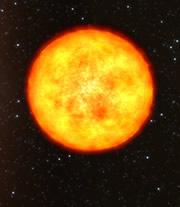What's been found?
 Artist's impression of a very, very old star: HE 1523-0901ESO
Artist's impression of a very, very old star: HE 1523-0901ESOA star, with the not-so catchy name of HE 1523-0901, that's estimated to be 13.2 billion years old (plus or minus 2 billion years) — almost as old as our 13.7-billion-year-old Universe. Despite being so old, it's quite nearby; it's in our Galaxy of the Milky Way.
Did we know that stars can be that old?
Yes — other really old stars have been found, such as the ancient CS 31082-001, estimated to be 14 billion years old.
Isn't that older than the Universe?
Well, yes, but that age estimate comes with an error bar of plus or minus 3 billion years. So (presumably) it's not actually older than the Universe it sits in. The first generation of stars are thought to have formed a few hundred million years after the Big Bang. Both of these ancients are probably slightly younger than that, forming roughly half a billion years after the big bang.
Is this ancient neighbour of ours still burning?
Definitely. Stars such as this one are thought to last longer than the age of the Universe now. Eventually they will cool down and become white dwarfs, which will then hang around until the end of time.
Is it still bright enough to be seen from Earth, despite being so old?
This kind of star is known as a bright giant, and its brightness from Earth has a value of 11.1 on a fairly confusing scale of brightness, in which the higher the number, the less bright the star is. Our Sun has a value of -26 on the same scale, and Venus, which is easy to spot with the naked eye, has a value of -4. So HE 1523-0901 is not very bright, but it can be seen with a normal telescope. "These stars are shining right on top of us," says Anna Frebel, at the University of Texas, Austin, who found the star.
How was this one found?
Frebel found the star by trawling through a bunch of stars already suspected to be fairly old. She found a hint of uranium (an element that can help to closely date a star) in one, so went back to take a closer look. Voilá — the granddaddy of stars was found.
And how did they measure its age?
In a similar way to the way objects are dated here on Earth — using radioactive isotopes. In this case, the metal-poor star had enough uranium and thorium to get a measurement using a spectrograph on the Very Large Telescope at the European Southern Observatory in Chile.
The half-life of uranium is 4.5 billion years; 14 billion years for thorium. Comparing ratios of the two elements, along with proportions of other metals such as europium, osmium and iridium, allowed Frebel to estimate the age of the star.
Can we use this star to find out things about the early Universe?
By studying 'neutron-capture elements' such as uranium, astronomers can learn about the supernova that produced the elements in the first place, before they formed into a star. It's almost impossible to recreate the nuclear synthesis process of supernovae in the lab, so theorists use stars as cosmic laboratories, to provide them with experimental data on which to base their theories.
Looking at old stars tells us what could be produced and how it was produced, allowing astronomers to work backwards to piece together the puzzle of what the Universe looked like chemically when it formed.
Can we find even older stars?
ADVERTISEMENT
Possibly. But the very first generation of stars were probably very big — 100 times as massive as our Sun — and so would have decayed quickly. They're long dead by now, says Frebel.
What's the oldest thing ever found in the Universe?
The cosmic microwave background (CMB) — the radiation left over by the Big Bang — is the oldest 'thing' ever seen. The heat of the CMB was used to age the Universe.
Visit our ontheoldeststars_in.html">newsblog to read and post comments about this story.
-
References
- Frebel A., et al. Astrophys. J., 660 . L117 - L120 (2007). | Article |
